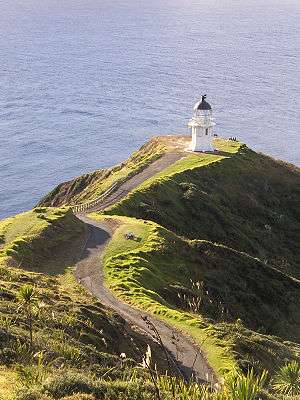Cape Reinga
Cape Reinga (Te Reinga or Te Rerenga Wairua in Māori) is the northwesternmost tip of the Aupouri Peninsula, at the northern end of the North Island of New Zealand. Cape Reinga is over 100 km north of the small town of Kaitaia. State Highway 1 extends all the way to the Cape. Suitable vehicles can also travel much of the way via Ninety Mile Beach and Te Paki stream bed.

The name of the cape comes from the Māori word 'Reinga', meaning the 'Underworld'. Another Māori name is 'Te Rerenga Wairua', meaning the leaping-off place of spirits. Both refer to the Māori belief that the cape is the point where the spirits of the dead enter the underworld.
Understand
History
Māori mythology
According to mythology, the spirits of the dead travel to Cape Reinga on their journey to the afterlife to leap off the headland and climb the roots of the 800-year-old tree and descend to the underworld to return to their traditional homeland of Hawaiiki-a-nui, using the Te Ara Wairua, the 'Spirits' pathway'. They turn briefly at the Three Kings Islands for one last look back towards the land, then continue on their journey.
A spring in the hillside, Te Waiora-a-Tāne (the 'Living waters of Tāne'), also played an important role in Māori ceremonial burials, representing a spiritual cleansing of the spirits, with water of the same name used in burial rites all over New Zealand. This significance lasted until the local population mostly converted to Christianity, and the spring was capped with a reservoir, with little protest from the mostly converted population of the area. However, the spring soon disappeared and only reappeared at the bottom of the cliff, making the reservoir useless.
Landscape
Cape Reinga is generally considered the separation marker between the Tasman Sea to the west and the Pacific Ocean to the east. From the lighthouse it is possible to watch the tidal race, as the two seas clash to create unsettled waters just off the coast. The Māori refer to this as the meeting of Te Moana-a-Rehua, 'the sea of Rehua' with Te Tai-o-Whitirea, 'the sea of Whitirea', Rehua and Whitirea being a male and a female respectively.
The cape is often mistakenly thought of as being the northernmost point of the North Island, and thus, of mainland New Zealand. However, North Cape's Surville Cliffs, 30 km east of Cape Reinga, are slightly further north. Another headland just to the west of Cape Reinga is Cape Maria van Diemen, which was discovered and named by the Dutch explorer Abel Tasman during his journey in 1642 and thought of by him to be the northernmost point of the newly-discovered country he named 'Staten Landt'.
Flora and fauna
Get in
The cape is at the end (or start) of SH1.
The cape is included on many coach tours to Ninety Mile Beach.
Fees and permits
No permits are required for a regular day visit.
Get around
State Highway 1 runs the length of the peninsula from Kaitaia to Cape Reinga. There is only one petrol station on the peninsula (Feb 2019) - about 2/3 of the way to the cape - so it is best to fuel up in Kaitaia.
Ninety Mile Beach is used as a road, but it is only viable for 4WD vehicles.
See
- 🌍 Lighthouse. The lighthouse at Cape Reinga was built in 1941 and first lit during May of that year, replacing a lighthouse on nearby Motuopao Island, which had been built 1879. In 1987, the lighthouse was fully automated and the lighthouse keepers were withdrawn. The previous 1000-watt light has since been replaced with a 50-watt flashing beacon. The lighthouse is about 15 minutes walk from the carpark.
Do
Buy
Eat
To respect local traditions, you are requested not to eat in the immediate cape area. It is recommended that you eat at the picnic area at Tapotupotu Bay, 5 km before you reach Cape Reinga, but not on the cape, which is a sacred area.
Drink
There is a drinking water fountain at the carpark.
Sleep
Camping
- 🌍 Kapowairua (Spirits Bay) Campsite, Spirits Bay Rd (turn off SH1 at Waitiki Landing). It is extremely popular with mosquitoes – they don't carry diseases, but their bites are irritating, so take insect repellent.
- 🌍 Tapotupotu Campsite (5 minutes drive, 3 hours walk from the cape). A fairly basic DOC campsite. Very popular with mosquitoes, though they are even more prolific at Kapowairua. $13.